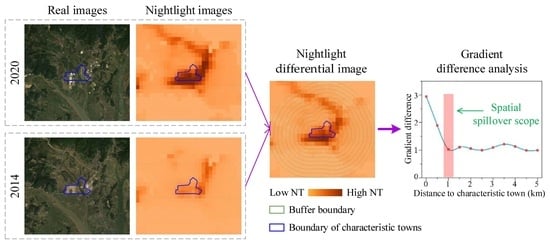Can Small Industrial Platforms Achieve Large Space Spillover? Identifying the Spatial Spillover Scope of Characteristic Towns Using the Gradient Difference Method
Abstract
:1. Introduction
2. Materials and Methodology
2.1. Study Area
2.2. Data Collection
2.3. Gradient Difference Method
3. Results
3.1. Spatial Spillover Types of Characteristic Towns
3.1.1. The Overall Characteristic of Spatial Spillover Types
3.1.2. Regional Differences of the Spatial Spillover Types
3.1.3. Regional Differences of Spatial Spillover Types in Industrial Types
3.2. Gradient Feature of Characteristic Towns
3.2.1. Different Types of Characteristic Towns
3.2.2. Industrial Types of Characteristic Towns
4. Discussion
4.1. Spatial Spillover Scope of Characteristic Towns
4.2. Application of the Gradient Difference Method
4.3. Limitations and Future Work
5. Conclusions
Supplementary Materials
Author Contributions
Funding
Data Availability Statement
Conflicts of Interest
References
- Bao, K.; Xia, Y.F. Carrier industrial space and China’s economic growth: On the development of sci-tech industrial parks and economic transformation in the past 30 years. Manag. World. 2008, 7, 1–6. [Google Scholar]
- Yang, Z.; Dunford, M. Cluster evolution and urban industrial dynamics in the transition from a planned to a socialist market economy: The case of Beijing. Spat. Econ. Anal. 2017, 12, 50–71. [Google Scholar] [CrossRef]
- Miao, J.T.; Phelps, N.A. ‘Featured town’fever: The anatomy of a concept and its elevation to national policy in China. Habitat Int. 2019, 87, 44–53. [Google Scholar] [CrossRef]
- Yao, S.J. Governance convergence in urban-rural Integration: Policy issues based on “characteristic town”. Soc. Sci. Res. 2017, 1, 45–50. [Google Scholar]
- Zou, Y.; Zhao, W. Searching for a new dynamic of industrialization and urbanization: Anatomy of China’s characteristic town program. Urban Geogr. 2018, 39, 1060–1069. [Google Scholar] [CrossRef]
- Zhang, R.L.; Ding, Y.; Liu, W.C.; Chai, Z.J. Practice and Exploration of Zhejiang characteristic town based on high-quality development. Urban Plan. Rev. 2020, 44, 67–74. [Google Scholar]
- Yu, J.; Xu, Z.X. The process and evolution logic of characteristic town policy: A case study of Zhejiang Province. Fisc. Sci. 2019, 6, 128–136. [Google Scholar]
- Feng, K.; Huang, X.Y. Accurately grasp the policy focus of promoting the development of characteristic towns: The enlightenment of Promoting the development of characteristic towns in Zhejiang and other places. China Dev. Watch. 2016, 18, 15–18. [Google Scholar]
- Li, Q. Characteristic town is the strategic choice of Innovation and development in Zhejiang Province. Zhejiang Today 2015, 24, 22–23. [Google Scholar]
- Qian, Y.; Liu, C.Y.; Ren, H.N. Development status and Policy Choices of Characteristic Towns. Macroecon. Manag. 2020, 9, 26–27. [Google Scholar]
- Sheng, S.H.; Zhang, W.M. Characteristic town: A form of industrial spatial organization. Zhejiang Soc. Sci. 2016, 3, 36–38. [Google Scholar]
- Wu, Y.; Chen, Y.; Deng, X.; Hui, E.C. Development of characteristic towns in China. Habitat Int. 2018, 77, 21–31. [Google Scholar] [CrossRef]
- Li, N.; Qiu, B.X. Research on industrial development and spatial Optimization of characteristic town based on complex adaptive system theory. Urban Dev. Res. 2019, 26, 8–12. [Google Scholar]
- Ma, Y.Q.; Ren, S.B. Transaction costs and the formation of urban carrier industry space: A case study of characteristic towns in Zhejiang Province. Urban Dev. Res. 2020, 27, 127–132. [Google Scholar]
- Zhou, L.Y.; Zhou, G.M. From development zone to characteristic town: New changes of regional development mode. Urban Dev. Res. 2017, 4, 51–55. [Google Scholar]
- Fu, X.D.; Jiang, Y.W. Research on the Development mode of Characteristic towns in China based on the perspective of grounding. China Soft Sci. 2017, 08, 102–111. [Google Scholar]
- Zeng, J.; Ci, F. Construction of characteristic towns under the background of new urbanization. Macroecon. Manag. 2016, 12, 51–56. [Google Scholar]
- Cheng, X.; He, J.X. The positive interaction between urban-rural integration development and characteristic town construction: Based on the perspective of urban-rural and regional factor flow Theory. Guangxi Soc. Sci. 2018, 10, 89–93. [Google Scholar]
- Liu, X.P. A scientific grasp of the functional positioning of characteristic towns in the new era. Macroecon. Res. 2019, 04, 153–161. [Google Scholar]
- Yin, X.; Wang, J.; Li, Y.; Feng, Z.; Wang, Q. Are small towns really inefficient? A data envelopment analysis of sampled towns in Jiangsu province, China. Land Use Policy 2021, 109, 105590. [Google Scholar] [CrossRef]
- Su, S.B.; Zhang, X.L. Analysis on the practice mode of Zhejiang characteristic towns in the new urbanization. Macroecon. Manag. 2016, 10, 73–75+80. [Google Scholar]
- Wang, D.W.; Li, Y. Typical problems and sustainable promotion strategies of characteristic town development. Econ. Rev. 2019, 08, 69–75. [Google Scholar]
- Hu, X.; Xu, W.; Miao, J.T. Think locally, act locally: A critique of China’s specialty town program in practice. Geogr. Rev. 2021, 111, 393–414. [Google Scholar] [CrossRef]
- Gao, S.J. Research on construction and development of characteristic small towns: A case study of Qingdao haiqing tea garden town. Issues Agric. Econ. 2017, 38, 40–44. [Google Scholar]
- Liu, H. Spatio-temporal evolution mechanism and influence factors of the China’s characteristic town policy and diffusion. Open J. Soc. Sci. 2020, 8, 328–340. [Google Scholar] [CrossRef]
- Min, X.Q. Characteristics of small towns from the perspective of precise governance and its construction path. J. Tongji Univ. 2016, 27, 55–60. [Google Scholar]
- Zheng, S.H.; Chen, J.; Mei, H.L.; Chen, Y.P. Research on the development of small towns with science and innovation characteristics based on the cooperation capacity of core enterprises. Sci. Res. Manag. 2020, 41, 143–152. [Google Scholar]
- Wang, T.Y. On the cultivation and development of characteristic towns under the background of rural revitalization Strategy: Based on the Interaction analysis of characteristic towns, smes and rural revitalization. Soc. Sci. Henan 2020, 28, 105–111. [Google Scholar]
- Zhou, F.; Zhao, F.; Xu, Q.; Yuan, Y.; Zhang, M. Evaluation and selection methods of tourism characteristic town: The case of Liaoning Province, China. Sustainability 2020, 12, 5372. [Google Scholar] [CrossRef]
- Huang, J.H.; Lu, N. Review of domestic characteristic town research: Progress and prospect. Contemp. Econ. Manag. 2018, 40, 47–51. [Google Scholar]
- Zheng, M.C.; Xu, G.; Xiao, R.; Jiao, L.M. Distance decay of nighttime lights from urban centers and its application. Prog. Geogr. 2022, 41, 1251–1260. [Google Scholar] [CrossRef]
- Imhoff, M.L.; Lawrence, W.T.; Stutzer, D.C.; Elvidge, C.D. A technique for using composite DMSP/OLS ‘‘city lights’’ satellite data to map urban area. Remote Sens. Environ. 1997, 61, 361–370. [Google Scholar] [CrossRef]
- Liu, Q.P.; Yang, Y.C.; Fu, D.X.; Li, H.; Tian, H. Urban spatial expansion based on DMSP/OLS nighttime light data in China in 1992–2010. Sci. Geogr. Sin. 2014, 34, 129–136. [Google Scholar]
- Li, D.R.; Yu, H.R.; Li, X. The spatial temporal pattern analysis of city development in countries along the Belt and Road Initiative based on nighttime light data. Geomat. Inf. Sci. Wuhan Univ. 2017, 42, 711–720. [Google Scholar]
- Doll, C.N.; Muller, J.P.; Morley, J.G. Mapping regional economic activity from night-time light satellite imagery. Ecol. Econ. 2006, 57, 75–92. [Google Scholar] [CrossRef]
- Henderson, J.V.; Storeygard, A.; Weil, D.N. Measuring economic growth from outer space. Am. Econ. Rev. 2012, 102, 994–1028. [Google Scholar] [CrossRef] [Green Version]
- Yang, M.Y.; Cai, Z.B.; Zhang, K.Y. Urban size measurement and its sources of spatial competition in China: Based on global nighttime light data. Financ. Trade Econ. 2017, 38, 38–51. [Google Scholar]
- Storeygard, A. Farther on down the road: Transport costs, trade and urban growth in sub-Saharan Africa. Rev. Econ. Stud. 2016, 83, 1263–1295. [Google Scholar] [CrossRef] [Green Version]
- Du, X.; Shen, L.; Wong, S.W.; Meng, C.; Yang, Z. Night-time light data based decoupling relationship analysis between economic growth and carbon emission in 289 Chinese cities. Sustain. Cities Soc. 2021, 73, 103119. [Google Scholar] [CrossRef]
- Elvidge, C.D.; Cinzano, P.; Pettit, D.R.; Arvesen, J.; Sutton, P.; Small, C.; Nemani, R.; Longcore, T.; Rich, C.; Safran, J.; et al. The Nightsat mission concept. Int. J. Remote Sens. 2007, 28, 2645–2670. [Google Scholar] [CrossRef]
- Hu, X.; Qian, Y.; Pickett, S.T.; Zhou, W. Urban mapping needs up-to-date approaches to provide diverse perspectives of current urbanization: A novel attempt to map urban areas with nighttime light data. Landsc. Urban Plan. 2020, 195, 103709. [Google Scholar] [CrossRef]
- Zheng, Y.; He, Y.; Zhou, Q.; Wang, H. Quantitative Evaluation of Urban Expansion using NPP-VIIRS Nighttime Light and Landsat Spectral Data. Sustain. Cities Soc. 2021, 76, 103338. [Google Scholar] [CrossRef]
- Chen, Z.; Yu, B.; Yang, C.; Zhou, Y.; Yao, S.; Qian, X.; Wang, C.; Wu, B.; Wu, J. An extended time series (2000–2018) of global NPP-VIIRS-like nighttime light data from a cross-sensor calibration. Earth Syst. Sci. Data 2021, 13, 889–906. [Google Scholar] [CrossRef]
- Jiao, L.M.; Xiao, F.T.; Xu, G. Spatial-temporal response of green land fragmentation patterns to urban expansion in Wuhan metropolitan area. Resour. Sci. 2015, 37, 1650–1660. [Google Scholar]
- Xue, B.; Xiao, X.; Li, J. Identification method and empirical study of urban industrial spatial relationship based on POI big data: A case of Shenyang City, China. Geogr. Sustain. 2020, 1, 152–162. [Google Scholar] [CrossRef]
- Wang, D.X.; Wang, S.Y.; Wu, Y.Z. Analysis and Optimization of Spatial Structure of Regional Small Towns: Taking Zhejiang Province as an Example. J. Zhejiang Univ. Technol. 2020, 19, 47–53. [Google Scholar]
- Liu, J.; Hou, X.; Wang, Z.; Shen, Y. Study the effect of industrial structure optimization on urban land-use efficiency in China. Land Use Policy 2021, 105, 105390. [Google Scholar] [CrossRef]
- Chen, X.S.; Zhang, K.Y. Regional Economic Theory; The Commercial Press: Beijing, China, 2003. [Google Scholar]
- Chen, W.; Zeng, J.; Chu, Y.; Liang, J. Impacts of Landscape Patterns on Ecosystem Services Value: A Multiscale Buffer Gradient Analysis Approach. Remote Sens. 2021, 13, 2551. [Google Scholar] [CrossRef]
- Shrestha, M.K.; York, A.M.; Boone, C.G.; Zhang, S. Land fragmentation due to rapid urbanization in the Phoenix Metropolitan Area: Analyzing the spatiotemporal patterns and drivers. Appl. Geogr. 2012, 32, 522–531. [Google Scholar] [CrossRef]
- Luck, M.; Wu, J. A gradient analysis of urban landscape pattern: A case study from the Phoenix metropolitan region, Arizona, USA. Landsc. Ecol. 2002, 17, 327–339. [Google Scholar] [CrossRef]
- Zhou, L.; Dang, X.; Mu, H.; Wang, B.; Wang, S. Cities are going uphill: Slope gradient analysis of urban expansion and its driving factors in China. Sci. Total Environ. 2021, 775, 145836. [Google Scholar] [CrossRef] [PubMed]
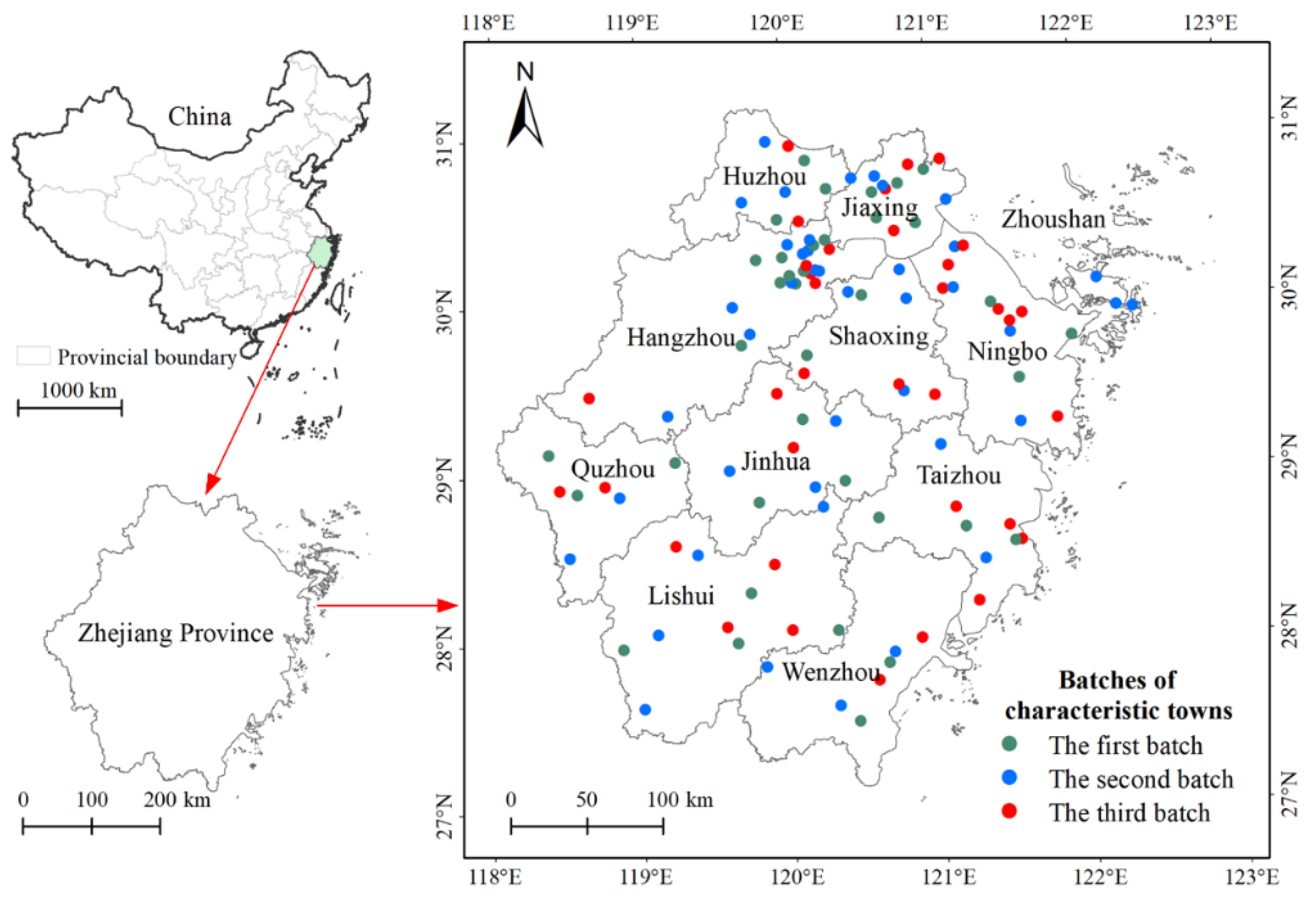
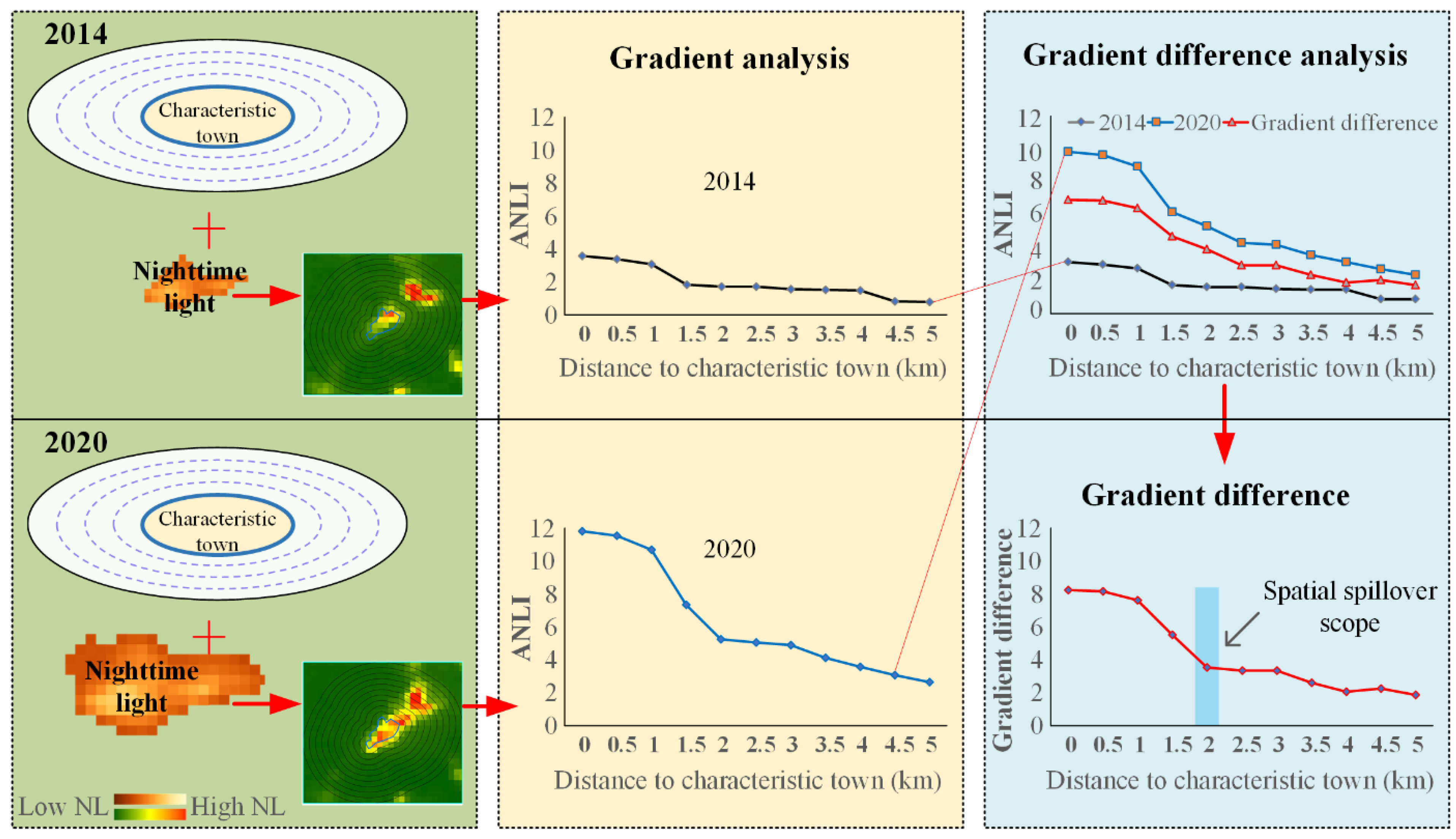
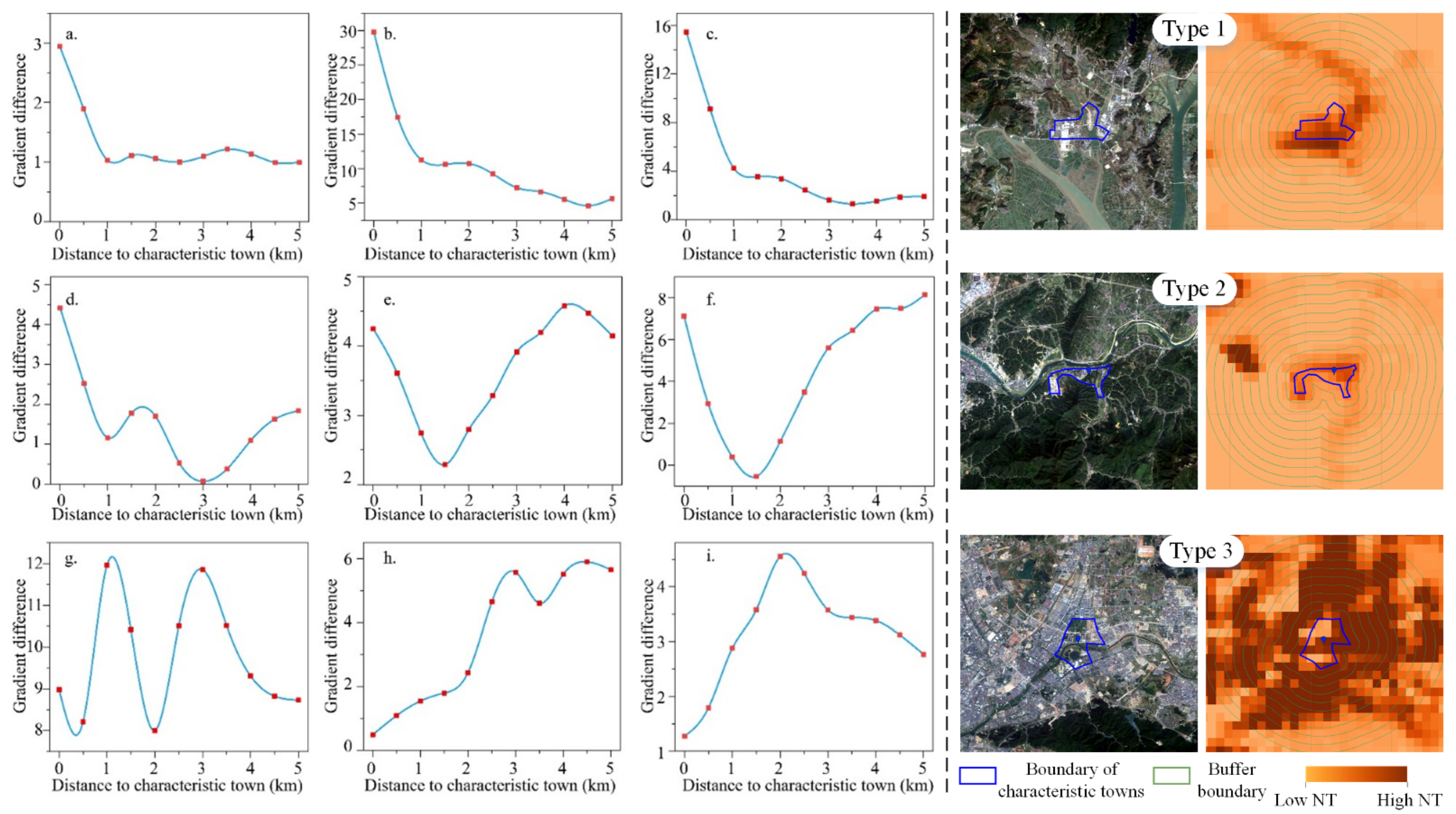
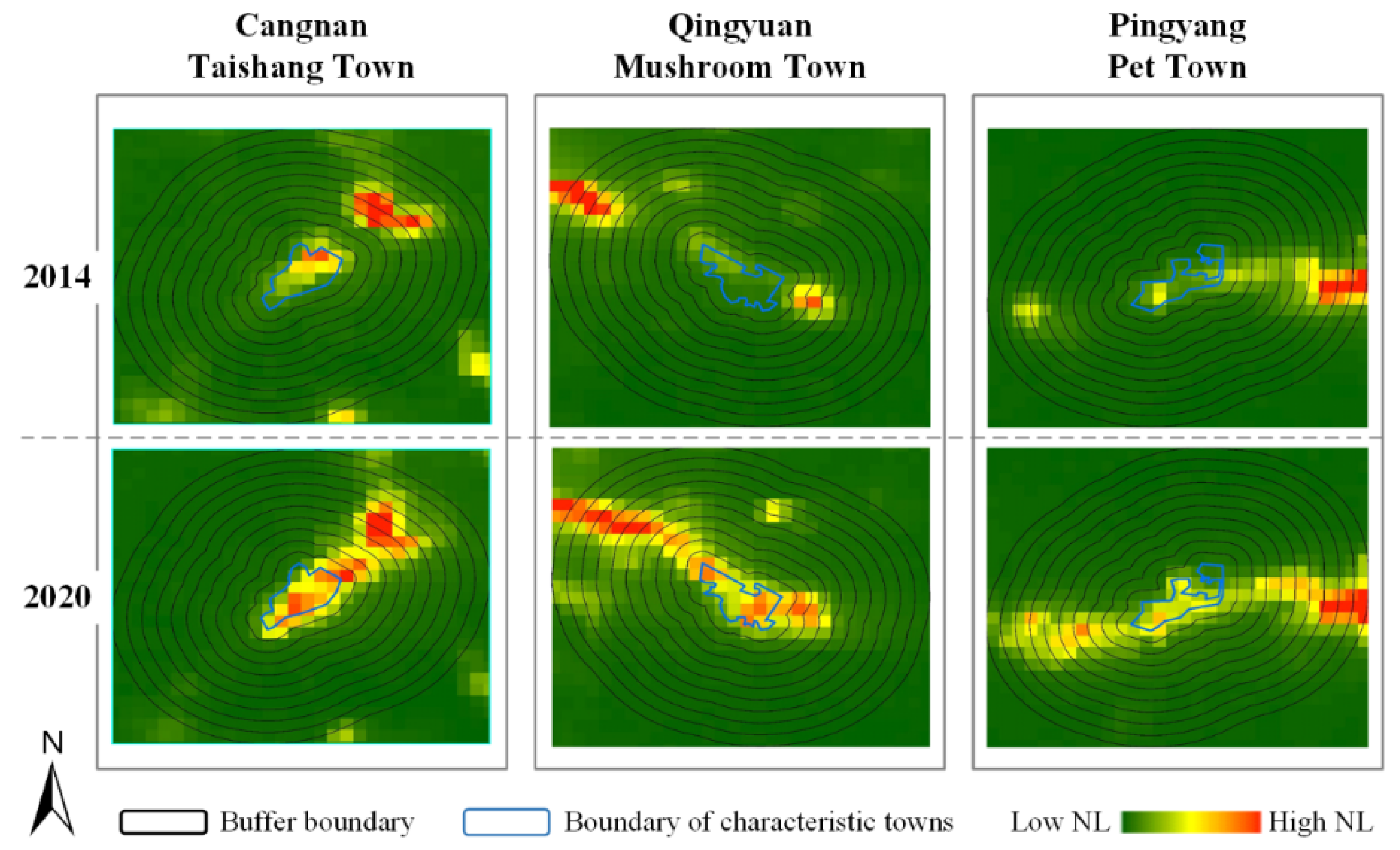
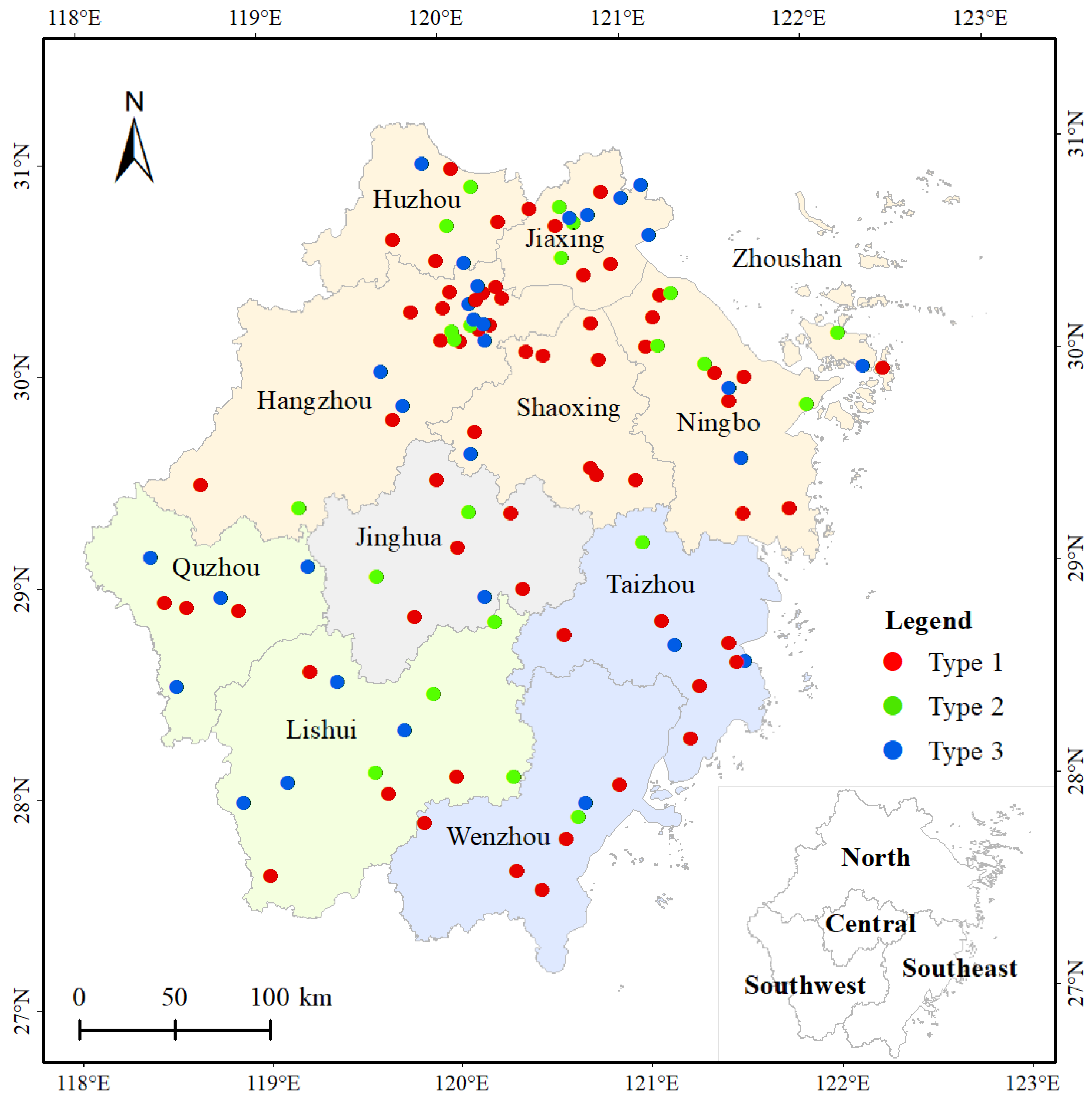
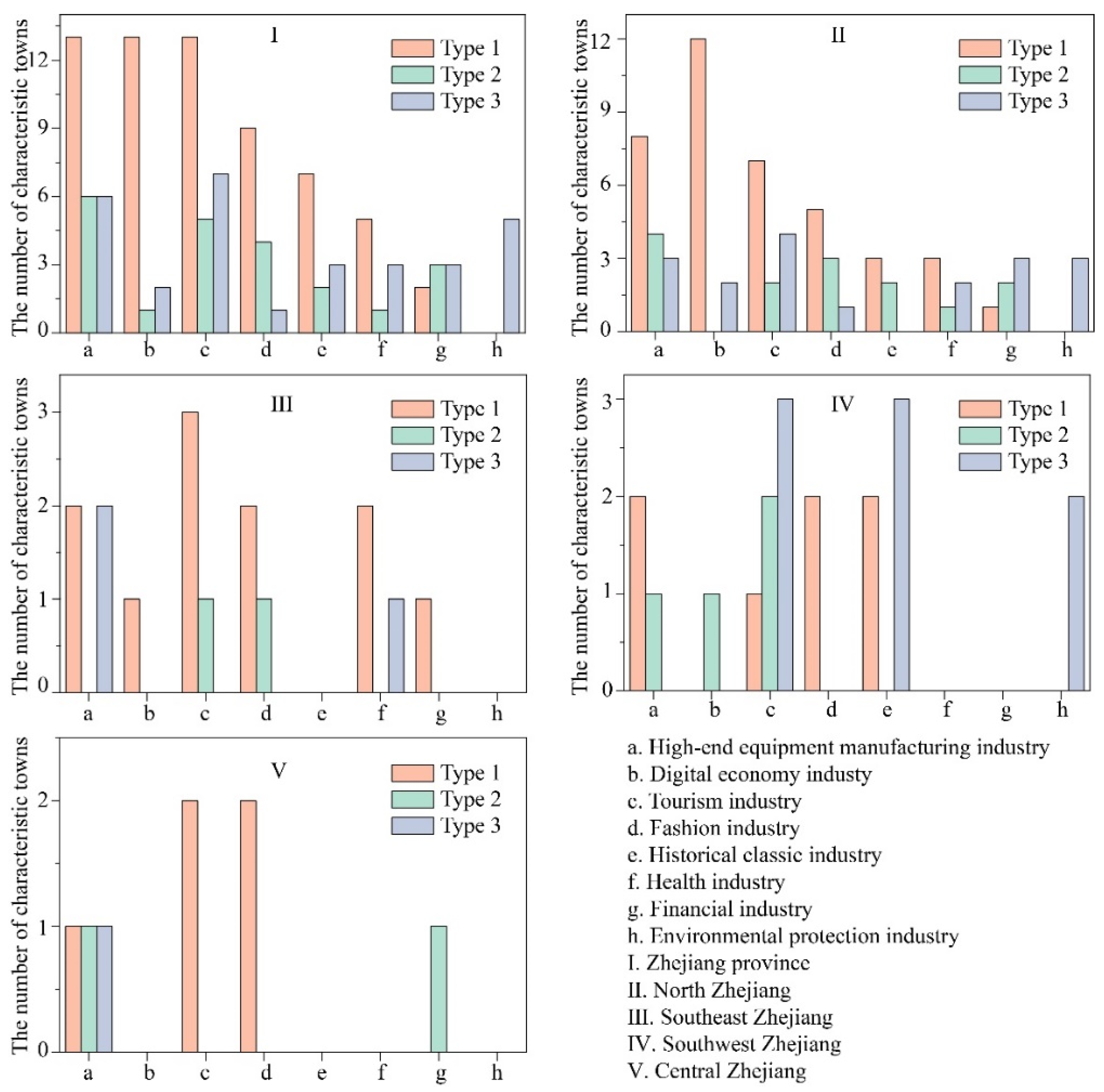
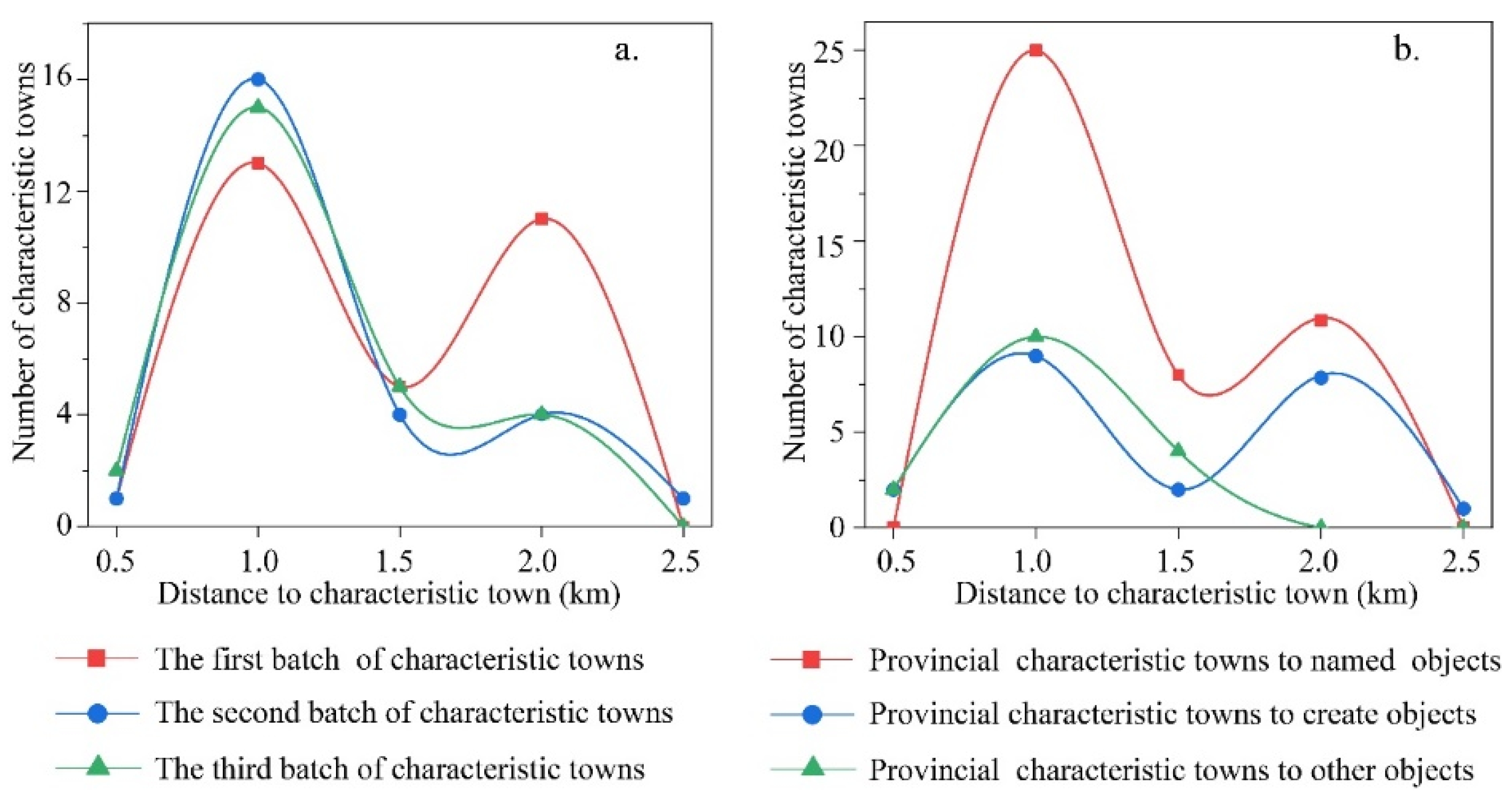

| The Type of Characteristic Towns | 2015 | 2016 | 2017 |
|---|---|---|---|
| The First Batch | The Second Batch | The Third Batch | |
| Provincial named characteristic towns | 26 | 19 | 12 |
| Provincial characteristic towns to cultivate objects | 2 | 9 | 6 |
| Provincial characteristic towns to create objects | 8 | 11 | 16 |
| Provincial characteristic towns to be eliminated | 1 | 3 | 1 |
| Total | 37 | 42 | 35 |
| Region | Type 1 | Type 2 | Type 3 | |||
|---|---|---|---|---|---|---|
| Number | Proportion | Number | Proportion | Number | Proportion | |
| North Zhejiang | 39 | 54.93% | 14 | 19.72% | 18 | 25.35% |
| Southeast Zhejiang | 11 | 68.75% | 2 | 12.50% | 3 | 18.75% |
| Southwest Zhejiang | 7 | 36.84% | 4 | 21.05% | 8 | 42.11% |
| Central Zhejiang | 5 | 62.50% | 2 | 25% | 1 | 12.50% |
Publisher’s Note: MDPI stays neutral with regard to jurisdictional claims in published maps and institutional affiliations. |
© 2022 by the authors. Licensee MDPI, Basel, Switzerland. This article is an open access article distributed under the terms and conditions of the Creative Commons Attribution (CC BY) license (https://creativecommons.org/licenses/by/4.0/).
Share and Cite
He, T.; Song, H.; Guo, A. Can Small Industrial Platforms Achieve Large Space Spillover? Identifying the Spatial Spillover Scope of Characteristic Towns Using the Gradient Difference Method. Remote Sens. 2022, 14, 3851. https://doi.org/10.3390/rs14163851
He T, Song H, Guo A. Can Small Industrial Platforms Achieve Large Space Spillover? Identifying the Spatial Spillover Scope of Characteristic Towns Using the Gradient Difference Method. Remote Sensing. 2022; 14(16):3851. https://doi.org/10.3390/rs14163851
Chicago/Turabian StyleHe, Tingting, Haipeng Song, and Andong Guo. 2022. "Can Small Industrial Platforms Achieve Large Space Spillover? Identifying the Spatial Spillover Scope of Characteristic Towns Using the Gradient Difference Method" Remote Sensing 14, no. 16: 3851. https://doi.org/10.3390/rs14163851
APA StyleHe, T., Song, H., & Guo, A. (2022). Can Small Industrial Platforms Achieve Large Space Spillover? Identifying the Spatial Spillover Scope of Characteristic Towns Using the Gradient Difference Method. Remote Sensing, 14(16), 3851. https://doi.org/10.3390/rs14163851







